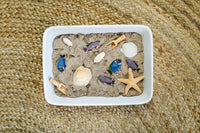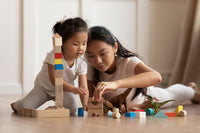Like we said, we all have them lying around the house or, if you’re super organized, properly stowed away in bins labeled by geographic region or habitat. Ours are in what we all call a “miscellaneous bin.” Does that make me super-organized, or not? But truth be told, I love to play animals with my kids. We have a healthy mix of Schleich horses, Wild Republic jungle animals, Safari Ltd. bugs and frogs, and then a handful of unidentifiable brands from the Dollar Store I expect. And so, researching other ways to play with our growing collection was an enjoyable task for me. So, we expanded our imaginations and uncovered 10 fun and inventive ways to use the animal figures you likely already have to continue encourage creative (and even educational) play.
- Make playdough footprints. You can just have fun making footprints in the playdough, or try to see if your little one can identify which tracks belong to which animals.
- Location, location, location. Divide your animals up by location or by habitat and pair them up with a map and other books about the region. For instance, you could gather all your African animals (i.e. lions, elephants, and giraffes) and read books like “A Parade of Elephants” by Kevin Heinkes or “Giraffes Can’t Dance” by Giles Andreae.
- Make a match. Have your child match up their animals with pictures of the animals in a book. There are also lots of cute animal cards you can get for this, too. This is a wonderful quiet-time matching activity that can help build your child’s concentration and visual perception.
- Even better, make a mom & baby match. In this case, your child matches the adult animal with its baby. Note, you can also try using the baby name for the animal, like “foal” instead or “baby horse.”
- Make a scene. Not the kind in a grocery store! Divide your animals into collections (i.e. farm animals; insects; marine animals) and use other objects and toys to expand their awareness of habitats. Bring in fences, tractors, and hay with the farm animals. Bring in grass, sticks, and rocks for the insects. Let your child play with the marine animals in water.
-
Create a sensory bin. Essentially an extension of the previous one, take it a step further with more complex sensory items. Have you ever used fake snow? It’s amazing and adds another dimension to your penguins and polar bears. Add corn kernels and rice to your farm animal scene; try dried beans and pasta in your insect habitat.
Check out our blog on “25 Sensory Bin Themes” for some ideas and inspiration.
- Tinker and discover. Create a discover basket or a tinker tray with your animals, which is essentially filling these containers with interesting, semi-related items and letting your child discover each item on their own. Pompoms, blocks, pine cones, leaves - anything goes. For older children, create a discovery basket with animals based on their geography and fill with items that relate.
- What doesn’t belong? Group related animals together, but include one that clearly doesn’t belong and have your child try to identify which one it is. For instance, grab a pig, a cow, a horse, and a giraffe. It’s a fun activity, but also great critical thinking practice.
- Songs & rhymes. This is great for little ones. Try matching animals up with certain songs and nursery rhymes that they know. Gather the animals and pick them out as you sing. Need some songs? Try “Old McDonald Had a Farm” or even “Hickory Dickory Dock” with different animals climbing the clock. Who says you have to just stick with a mouse?
- A guessing game. Remember when you were a kid and one activity during the class field trip to the science museum was to reach into a bag, feel around, and guess what the object was? Try this at home with animals and have your child try to guess what animal it is by using their sense of touch.
Why Playing with Animals Matters
- Playing with animal figures can encourage creative play and expand the imagination.
- Using animal figures during play can also help a child’s emotional development; they often “practice” emotional situations with figures. If an animal is hurt or lost in the game, a child can begin may bring in the mother to care for her baby.
- A child’s play with animal figures may aid in their language development. They create stories and dialogue between animals, and you’ll often hear your own words and phrases repeated in this way.







